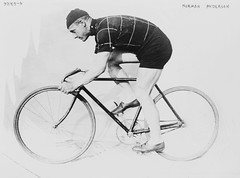By Linda Keenan
When I meet a mother these days who does not have a child in occupational or physical therapy, I have the urge to shake her violently, maybe slap her, and say, "Are you mad, woman? Don't you know that something is wrong with your child?! Don't you care about Seamus/Suri/Maeve/Shiloh (take your pick)?"
OK, that was a joke, but it goes to the dilemma I've faced over the past 6 months. I had to decide whether to "label" my child, something that caused a bit of family strife and internal conflict. I came to the conclusion that, like it or not, the new normal of childhood is abnormal. And I found my near 40-year-old self caving to peer pressure, like an insecure teenager at a beer pong party.
My toddler has always been tightly wound and when he began preschool the director made it clear within two days she thought something was wrong with him. (Back story: at 3 years old, he had never been in any childcare, and because we are sadly lacking in grandparents or family close by, my son had never been in the care of anyone other than his parents. And I mean no one, not once, ever.) When pressed, the director used the phrase “Pervasive Developmental Disorder – Not Otherwise Specified,” and then tried to console me about this by saying "all of us could be diagnosed with something!"
At home minutes later, furious googling ensued, showing PDD to be on the autism spectrum. Since you can see that I am splaying out this sorry saga for perfect strangers to read, you might suspect that I am not one to suffer through problems silently. After I got this news from the preschool director, I proceeded to tell everyone I knew about it, and even people I didn't know, like my unsuspecting seat mates at Starbucks.
The first thing I noticed was the stark generational difference. Anyone over the age of 50 (including a close relative) believed strenuously that we had medicalized every normal trait of childhood, that "rambunctious" had become ADD, that "sassing back" had become Oppositional Defiant Disorder, that "shy" and "nervous" had become mild autism, "sensitive" had become Sensory Integration Disorder, "awkward" had become Asperger's, "klutzy" had become a gross motor deficit. And they believed that medicalizing the natural diversity of child behavior was one step away from medicating the child, which they viewed as an unmitigated travesty (their view, not mine).
The second thing I realized was that among the parents I knew, well over 50 percent had their child in some form of therapy (I counted), hence my assertion that the new normal was in fact abnormal, a claim that would certainly make a statistician's head spin.
So it was with these competing impressions that I entered the evaluation process with our public school district. Frank was not found to have PDD, but rather a fine motor deficit and also a lack of "body awareness" (known to the pros as proprioception), which, in the evaluators' eyes, explained an array of seemingly disparate behaviors.
Did I believe any of it? Without question, I knew my son was well behind on fine motor skills. As for proprioception, well, I'm not sure I buy it. I'm not saying there aren't behavioral challenges for my son (which, by the way, have greatly improved after six months of school), but I'm not positive that lacking body awareness is at the root of them all. I should also say that my natural contrarian inclination would lead me to side with the older generation, who think we run the risk of turning borderline quirks into maladies.
But here's the ruthlessly honest truth of how I decided what to do. I did something because everyone else was doing it; I was undeniably a lemming. I chose to accept therapy and the attendant label because, frankly, more than half of my friends or acquaintances had done the same (even the ones like me who view the labels for marginal problems as faintly absurd).
I felt as if my son would be at a disadvantage if he did not get the therapy offered by the school district. I wish I could say my decision-making had more integrity. Maybe I can blame my lack of spine on my (diagnosed) pre-menopausal anxiety disorder. I just hope my son doesn't one day read this. I can hear myself saying to my rebellious teenager, "well, if everyone else jumped off a bridge, would you jump too?" And his answer, rightly, would be "well YOU did, Mom!"
Linda Keenan is a contributing writer at Burbia. Linda worked 7 years as a head writer/senior producer for various programs on CNN. Before that she worked as a writer/producer for Bloomberg TV. She now writes satire, primarily about parenting culture, at Thoroughly Modern Mommy.......read more rantsOriginal here
 SQUARE MARKS THE SPOT: New neurons visualized via NMR spectroscopy. The methodology may allow researchers to see how young neurons behave in neurological disorders.
SQUARE MARKS THE SPOT: New neurons visualized via NMR spectroscopy. The methodology may allow researchers to see how young neurons behave in neurological disorders.


 The greatest challenge in developing a permanent exercise habit is finding motivation that lasts. It’s easy to get to the gym when you’re preparing for that big beach vacation or want to look great for your high school reunion. But what about the rest of the time?
The greatest challenge in developing a permanent exercise habit is finding motivation that lasts. It’s easy to get to the gym when you’re preparing for that big beach vacation or want to look great for your high school reunion. But what about the rest of the time?

























